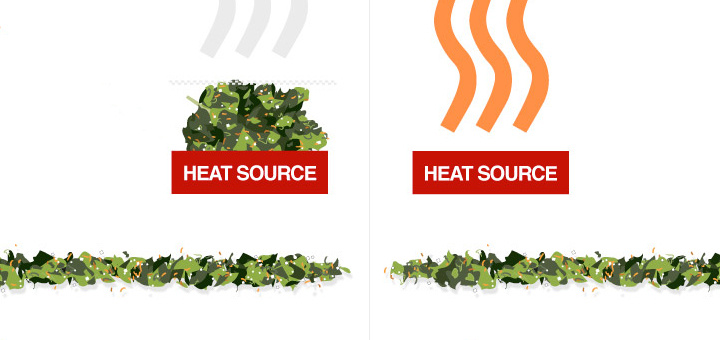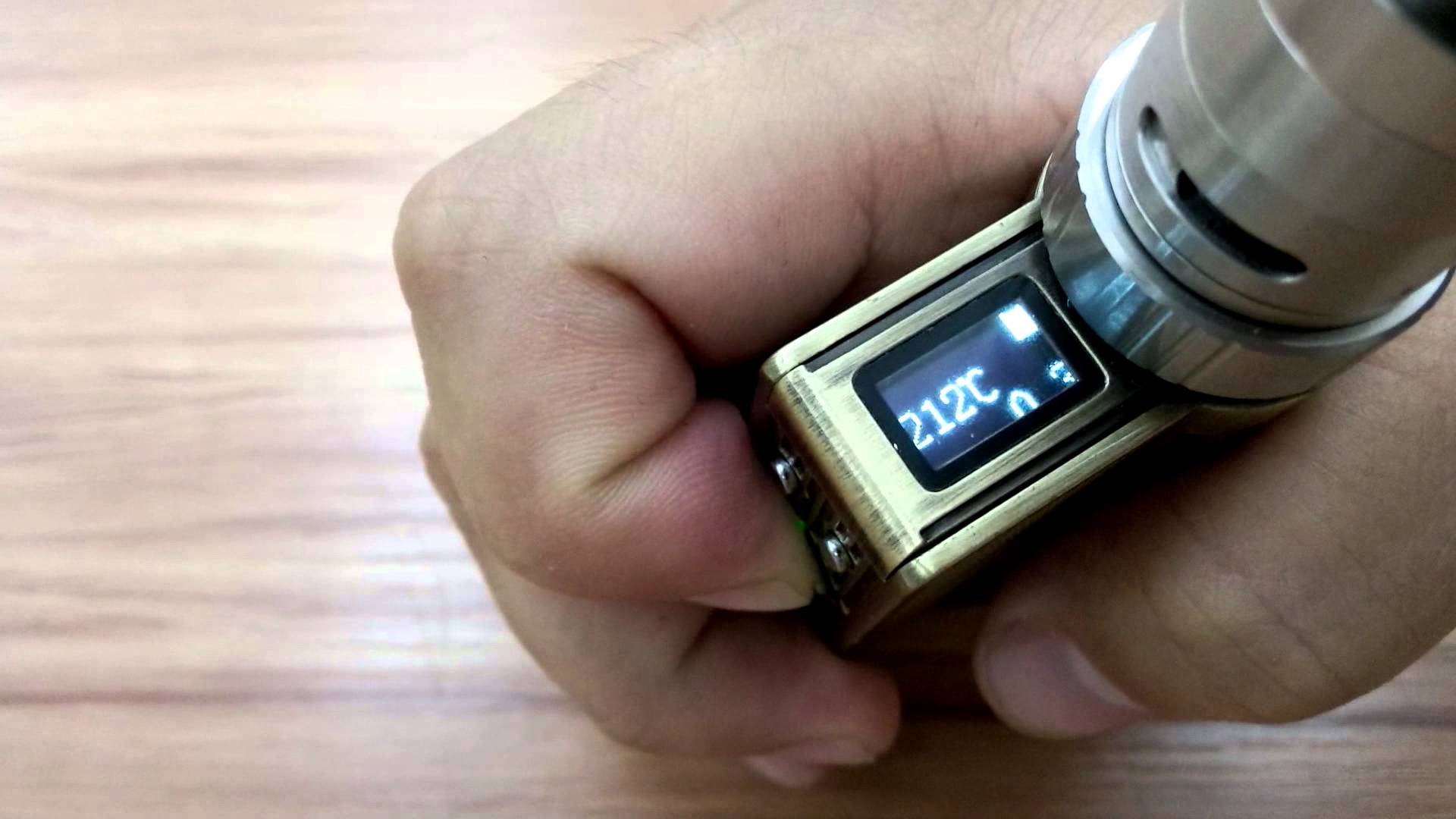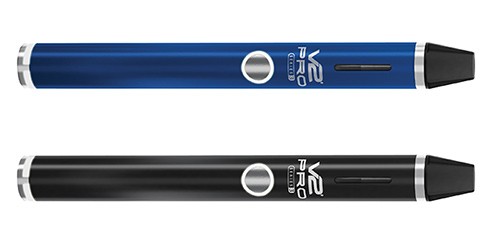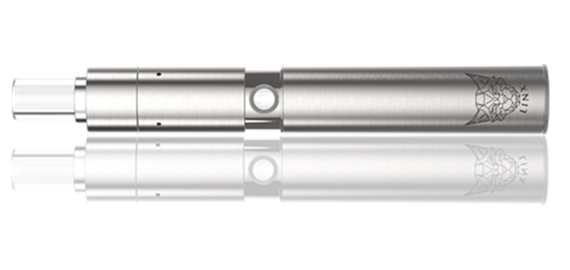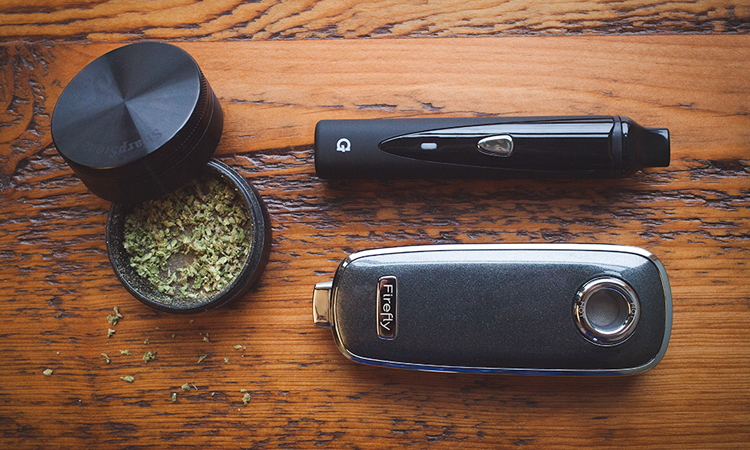Marijuana Vaporizers: A Beginner’s Guide
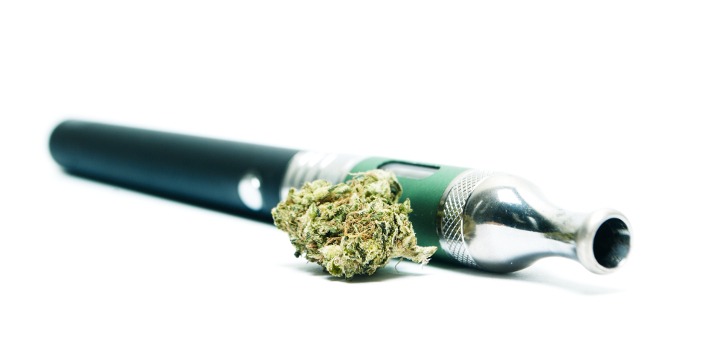
(Photo: Doug Shutter/Shutterstock)
Vaporizing is a safe and healthy alternative to smoking cannabis.
Vaporizing (or “vaping”) has been getting a lot of attention lately as a safer way of consuming nicotine than smoking cigarettes.
The e-cigarette has become more popular than ever in recent years, and it seems like vape shops are popping up on every corner.
While marijuana vaporizers are different than e-cigarettes, the principle is the same. Vaporizers can be used to deliver THC from marijuana in a way that avoids the health drawbacks of smoking.
Many people still choose to smoke marijuana, but studies show that vaporizing can be safer and more effective in the long run.
How It Works
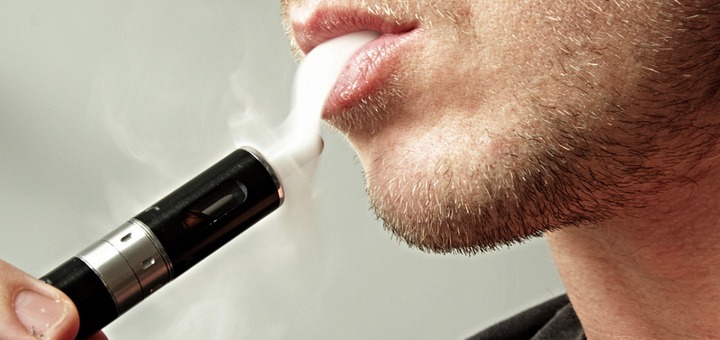
(Photo: Jon Williams/Flickr)
What are vaporizers? How do they work?
Vaporizers are devices that heat marijuana to the point where its active ingredients are released in a gas that can be inhaled, while avoiding combustion (burning) and the production of smoke.
Combustion and smoke normally occur at above 230°C (446°F), while vaporizers operate at a lower temperature range.
The vapor or gas produced by a marijuana vaporizer consists mainly of THC, other cannabinoids, and terpenes.
THC is the main active ingredient in marijuana responsible for the high. Terpenes are fragrant compounds that give marijuana its particular flavor and scent.
When you vaporize marijuana, these compounds get mixed together, resulting in a flavourful, potent hit.
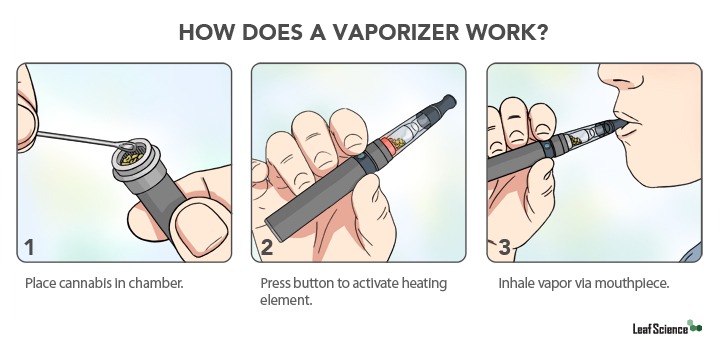
A typical dry herb vaporizer has a battery/power supply, an herb chamber, a heating element, a mouthpiece, and buttons/dials for control.
When marijuana is placed in the chamber and the device is turned on, the heating element heats the marijuana to the desired temperature, and the vapor is released and pulled out of the device via the mouthpiece.
Popular vaporizers include the Volcano, the PAX 2, and the Magic Flight Launch Box. Vaporizers come in desktop, portable, and pen form, and can be used with dry herb, wax/oil, or e-liquids.
Vaporizing vs. Smoking
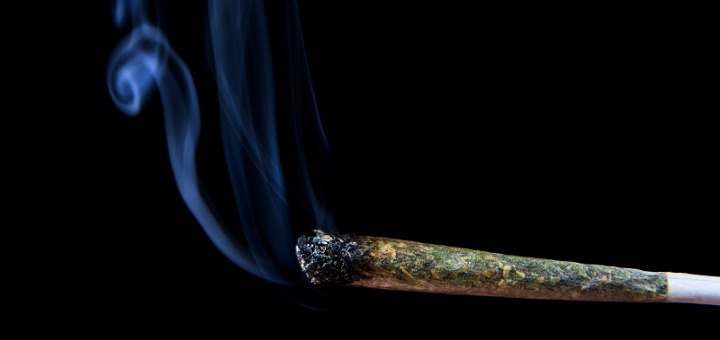
(Photo: Jan Havlicek/Shutterstock)
Let’s set the record straight: smoking marijuana is not as bad for your lungs as smoking cigarettes.
Smoking methods for marijuana include joints/spliffs, bongs, pipes, and dabbing. These are by far the most common ways of consuming marijuana, and casual users tend to be most familiar with these tried-and-true methods of getting high.
Unlike cigarette smokers, marijuana smokers don’t appear to be at any increased risk for lung cancer or permanent lung damage.
However, smoking is still not recommended due to negative effects on the respiratory system.
Smoking marijuana has been linked to respiratory problems, including bronchitis, a type of lung inflammation. Symptoms of bronchitis include cough, phlegm, shortness of breath, and a sore throat.
This could be explained by the fact that smoking weed is known to weaken the immune defenses of the lungs, leaving them more vulnerable to infection. Small tar deposits have also been found in the lungs of marijuana smokers.
Vaporizing avoids these problems by delivering the active compounds in marijuana without the harmful and irritating by-products created by smoking.
Types of Marijuana Vaporizers
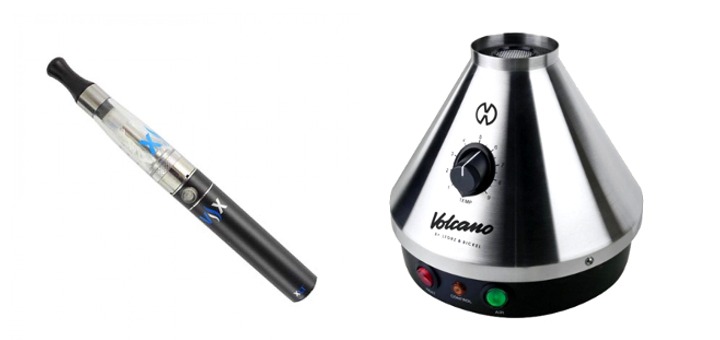
There are 3 major types of marijuana vaporizers: desktop vaporizers, portable vaporizers, and vape pens.
Vape pens and portable vaporizers are small portable devices. Vape pens, like the Dr. Dabber Aurora, tend to be used with oil and wax products, while portable vapes, like the Firefly or the PAX 2 are usually compatible with dry herbs.
Desktop or tabletop vaporizers are bigger devices that can produce large quantities of vapor. The most well known is the Volcano vaporizer. Other popular desktop models include the Extreme Q, Vapir Rise and Herbalizer.
These vaporizers work by filling a bag with marijuana vapor, which can then be inhaled through a mouthpiece on the bag.
One major decision any vape user has to make is whether they want a conduction or convection vaporizer. Conduction models apply heat directly to marijuana, while convection models heat the air around the marijuana to warm it indirectly.
Conduction vaporizers are cheaper, but have the drawback of uneven heating. Convection vaporizers are expensive and take longer, but heat more evenly and produce a better result.
Temperature for Vaporizing
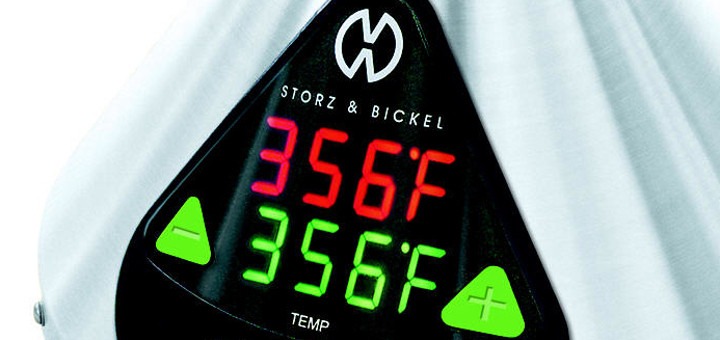
The best temperature for vaporizing would maximize the amount of cannabinoids and terpenes released, while minimizing toxic by-products.
In a 2004 study, scientists vaporized marijuana using the Volcano vaporizer at temperatures between 155-218°C (311-424°F). The researchers analyzed the composition of vapor produced at different temperatures. They also compared the composition of the vapor to marijuana smoke.
The study concluded that a vaporizing temperature of 185°C (365°F) maximizes beneficial compounds such as THC, CBD, and terpenes, while minimizing harmful compounds found in smoke.
These days, many vaporizers allow you to set and control the temperature. This means users can choose which temperature to vape at in order to enjoy the benefits of specific compounds.
Vaporizing points of major cannabinoids and terpenes
Compound Vaporizing Point (°C)
∆-9-tetrahydrocannabinol (THC) 157
Cannabidiol (CBD) 160-180
Cannabinol (CBN) 185
Cannabichromene (CBC) 220
Cannabigerol (CBG) 52
∆-8-tetrahydrocannabinol (∆-8-THC) 175-178
β-myrcene 166-168
β-caryophyllene 119
d-limonene 177
α-pinene 156
α-terpeneol 217-218
THC and CBD are two major cannabinoids found in marijuana. THC is the main active ingredient in marijuana responsible for the high, while CBD is responsible for non-psychoactive effects such as analgesic and anti-anxiety effects.
Terpenes are fragrant compounds that give marijuana its particular flavour and scent. They also have significant effects on the body, such as pain-relieving and anti-inflammatory effects.
Benefits of Vaporizing

(Photo: Pixabay)
What are the advantages of using a vaporizer?
Studies have shown clear benefits to vaporizing as opposed to smoking marijuana.
The main benefits include a reduction of harmful compounds such as tar, fewer respiratory symptoms and more efficient delivery of THC. Other reported benefits include a cleaner taste and stealth/discretion.
Marijuana vapor contains less toxins.
A 2004 study compared the composition of marijuana vapor and smoke and found the smoke contained many more compounds, including known toxins.
The vapor was more pure and consisted mainly of cannabinoids and terpenes.
Another study, conducted in 2007, took blood samples from subjects who smoked or vaporized marijuana. They found that the subjects had similar levels of THC in their blood, but vape users had lower levels of carbon monoxide.
Carbon monoxide is a by-product of combustion that can cause serious poisoning and even death at high concentrations.
Vaporizing avoids the lung problems caused by smoking.
When marijuana smokers switch to using a vaporizer, they tend to have less respiratory problems.
A 2006 study by Earleywine and Barnwell analyzed self-reported respiratory symptoms in cannabis users, and found that vaporizer use predicted lower levels of respiratory problems.
Another 2010 study by Van Dam and Earleywine took marijuana smokers and switched them to vaping for 1 month.
When they compared users’ reports of lung symptoms before and after, they found that switching to a vaporizer led to a reduction in symptoms.
Vaporizing is an efficient delivery method.
A 2004 study, which compared the composition of marijuana vapor and smoke, found that vaporizing is at least as efficient as smoking, and possibly more.
Users generally agree that vaping is more effective and that they require less marijuana to achieve the same high.
This could be due to the fact that some THC is lost in the “sidestream smoke” — smoke that gets lost in the air while a joint is burning.
With vaping, less THC gets lost in this way because the mouthpiece delivers the vapor directly to the user, and the user has control over the heating element.
Smoking methods such as joints or pipes also result in the destruction of some THC due to high temperatures.
Users report more stealth and a cleaner taste.
A 2014 study researched the experiences of vaporizer users. They identified the stealthy aspects of vaporizing as a major benefit, including the lack of odor and lack of visible smoke.
Users also said they enjoyed the cleaner flavor of vapor as opposed to the harsh taste of smoke.
Vaporizing also provides more control over dosing compared to smoking. Vaporizers tend to be more consistent and often feature precise temperature settings.
Achieving a consistent dose can be challenging when smoking. It’s hard to pack two bowls exactly the same!
Drawbacks of Vaporizing
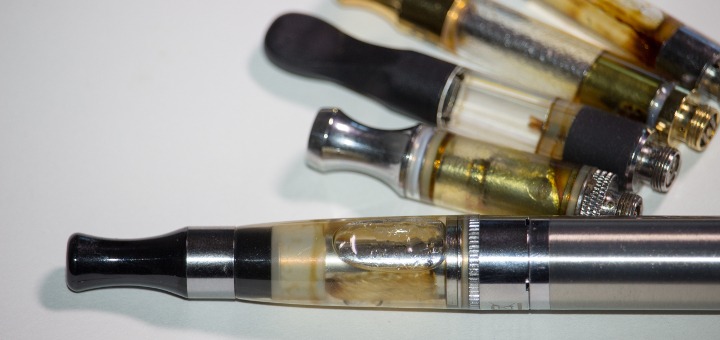
(Photo: King Dragon/Shutterstock)
What are the risks and drawbacks of vaporizers?
Like most things, vaporizing may have some drawbacks as well. One major concern is that there are currently no long-term studies on the safety and health effects of vaporizing.
Vaporizing could pose a health risk.
Dr. Mitch Earleywine, who published two studies on the effects of vaporizing on the respiratory system, suggests that it still makes sense to switch to vaping, because it has been shown in studies to at least be safer than smoking.
“I think it is clear that smoking anything is not ideal for health. What little research we have seems to strongly favor vaporizing over smoking,” he explains.
There are also some concerns with heating propylene glycol (PG), a chemical commonly used in vaporizer e-liquids. Propylene glycol is safe for ingestion and topical application, but it hasn’t been evaluated for inhalation. If you’re concerned, it’s best to stick to dry herb vaporizers.
Certain vaporizers may be of poor quality, and could leach chemicals into the vapor. When it comes to the air you’re breathing, it’s probably best to splurge for a reputable brand.
Vaporizing may seem like an ideal method at first. But it’s important to recognize which of marijuana’s risks it can address, and which it can’t.
Marijuana poses other risks, such as adverse psychological effects and addiction, and vaporizing can’t address these.
Vaporizing has practical drawbacks, too.
Vaporizing has expensive start-up costs. A desktop vaporizer will run you at least $200, while portable models start at $80. For some people, especially occasional users, it just doesn’t make sense to invest that kind of money.
New or inexperienced users may also find they accidentally get too high. For one, you don’t lose as much THC in the sidestream smoke. Second, the vapor has a cleaner tasteand is less harsh than smoke, so it’s easier to inhale more.
Vaporizing also take a little more time. Vaporizers must heat up before releasing vapor, so they’re not ideal if you just want a quick hit on your way out the door.
Summary
Vaporizers heat marijuana (dry herb, wax/oil, or e-liquids) to a temperature where the active ingredients are released into a gas, but not so hot as to produce smoke.
Smoking marijuana creates harmful by-products and tar similar to what is found in tobacco smoke.
Vaporizing avoids the drawbacks of smoking while offering many of the same conveniences, such as rapid effects and the ability to easily control your dose.
While vaporizing does require an upfront investment, it pays off by reducing users’ respiratory symptoms.
Long-term studies are still needed to determine the safety of vaporizers.
Marijuana users should compare the pros and cons of vaporizers with other consumption methods to decide what works best for them.
- — APR 20, 2017

(Photo: Doug Shutter/Shutterstock)
Vaporizing is a safe and healthy alternative to smoking cannabis.
Vaporizing (or “vaping”) has been getting a lot of attention lately as a safer way of consuming nicotine than smoking cigarettes.
The e-cigarette has become more popular than ever in recent years, and it seems like vape shops are popping up on every corner.
While marijuana vaporizers are different than e-cigarettes, the principle is the same. Vaporizers can be used to deliver THC from marijuana in a way that avoids the health drawbacks of smoking.
Many people still choose to smoke marijuana, but studies show that vaporizing can be safer and more effective in the long run.
How It Works

(Photo: Jon Williams/Flickr)
What are vaporizers? How do they work?
Vaporizers are devices that heat marijuana to the point where its active ingredients are released in a gas that can be inhaled, while avoiding combustion (burning) and the production of smoke.
Combustion and smoke normally occur at above 230°C (446°F), while vaporizers operate at a lower temperature range.
The vapor or gas produced by a marijuana vaporizer consists mainly of THC, other cannabinoids, and terpenes.
THC is the main active ingredient in marijuana responsible for the high. Terpenes are fragrant compounds that give marijuana its particular flavor and scent.
When you vaporize marijuana, these compounds get mixed together, resulting in a flavourful, potent hit.

A typical dry herb vaporizer has a battery/power supply, an herb chamber, a heating element, a mouthpiece, and buttons/dials for control.
When marijuana is placed in the chamber and the device is turned on, the heating element heats the marijuana to the desired temperature, and the vapor is released and pulled out of the device via the mouthpiece.
Popular vaporizers include the Volcano, the PAX 2, and the Magic Flight Launch Box. Vaporizers come in desktop, portable, and pen form, and can be used with dry herb, wax/oil, or e-liquids.
Vaporizing vs. Smoking

(Photo: Jan Havlicek/Shutterstock)
Let’s set the record straight: smoking marijuana is not as bad for your lungs as smoking cigarettes.
Smoking methods for marijuana include joints/spliffs, bongs, pipes, and dabbing. These are by far the most common ways of consuming marijuana, and casual users tend to be most familiar with these tried-and-true methods of getting high.
Unlike cigarette smokers, marijuana smokers don’t appear to be at any increased risk for lung cancer or permanent lung damage.
However, smoking is still not recommended due to negative effects on the respiratory system.
Smoking marijuana has been linked to respiratory problems, including bronchitis, a type of lung inflammation. Symptoms of bronchitis include cough, phlegm, shortness of breath, and a sore throat.
This could be explained by the fact that smoking weed is known to weaken the immune defenses of the lungs, leaving them more vulnerable to infection. Small tar deposits have also been found in the lungs of marijuana smokers.
Vaporizing avoids these problems by delivering the active compounds in marijuana without the harmful and irritating by-products created by smoking.
Types of Marijuana Vaporizers

There are 3 major types of marijuana vaporizers: desktop vaporizers, portable vaporizers, and vape pens.
Vape pens and portable vaporizers are small portable devices. Vape pens, like the Dr. Dabber Aurora, tend to be used with oil and wax products, while portable vapes, like the Firefly or the PAX 2 are usually compatible with dry herbs.
Desktop or tabletop vaporizers are bigger devices that can produce large quantities of vapor. The most well known is the Volcano vaporizer. Other popular desktop models include the Extreme Q, Vapir Rise and Herbalizer.
These vaporizers work by filling a bag with marijuana vapor, which can then be inhaled through a mouthpiece on the bag.
One major decision any vape user has to make is whether they want a conduction or convection vaporizer. Conduction models apply heat directly to marijuana, while convection models heat the air around the marijuana to warm it indirectly.
Conduction vaporizers are cheaper, but have the drawback of uneven heating. Convection vaporizers are expensive and take longer, but heat more evenly and produce a better result.
Temperature for Vaporizing

The best temperature for vaporizing would maximize the amount of cannabinoids and terpenes released, while minimizing toxic by-products.
In a 2004 study, scientists vaporized marijuana using the Volcano vaporizer at temperatures between 155-218°C (311-424°F). The researchers analyzed the composition of vapor produced at different temperatures. They also compared the composition of the vapor to marijuana smoke.
The study concluded that a vaporizing temperature of 185°C (365°F) maximizes beneficial compounds such as THC, CBD, and terpenes, while minimizing harmful compounds found in smoke.
These days, many vaporizers allow you to set and control the temperature. This means users can choose which temperature to vape at in order to enjoy the benefits of specific compounds.
Vaporizing points of major cannabinoids and terpenes
Compound Vaporizing Point (°C)
∆-9-tetrahydrocannabinol (THC) 157
Cannabidiol (CBD) 160-180
Cannabinol (CBN) 185
Cannabichromene (CBC) 220
Cannabigerol (CBG) 52
∆-8-tetrahydrocannabinol (∆-8-THC) 175-178
β-myrcene 166-168
β-caryophyllene 119
d-limonene 177
α-pinene 156
α-terpeneol 217-218
THC and CBD are two major cannabinoids found in marijuana. THC is the main active ingredient in marijuana responsible for the high, while CBD is responsible for non-psychoactive effects such as analgesic and anti-anxiety effects.
Terpenes are fragrant compounds that give marijuana its particular flavour and scent. They also have significant effects on the body, such as pain-relieving and anti-inflammatory effects.
Benefits of Vaporizing

(Photo: Pixabay)
What are the advantages of using a vaporizer?
Studies have shown clear benefits to vaporizing as opposed to smoking marijuana.
The main benefits include a reduction of harmful compounds such as tar, fewer respiratory symptoms and more efficient delivery of THC. Other reported benefits include a cleaner taste and stealth/discretion.
Marijuana vapor contains less toxins.
A 2004 study compared the composition of marijuana vapor and smoke and found the smoke contained many more compounds, including known toxins.
The vapor was more pure and consisted mainly of cannabinoids and terpenes.
Another study, conducted in 2007, took blood samples from subjects who smoked or vaporized marijuana. They found that the subjects had similar levels of THC in their blood, but vape users had lower levels of carbon monoxide.
Carbon monoxide is a by-product of combustion that can cause serious poisoning and even death at high concentrations.
Vaporizing avoids the lung problems caused by smoking.
When marijuana smokers switch to using a vaporizer, they tend to have less respiratory problems.
A 2006 study by Earleywine and Barnwell analyzed self-reported respiratory symptoms in cannabis users, and found that vaporizer use predicted lower levels of respiratory problems.
Another 2010 study by Van Dam and Earleywine took marijuana smokers and switched them to vaping for 1 month.
When they compared users’ reports of lung symptoms before and after, they found that switching to a vaporizer led to a reduction in symptoms.
Vaporizing is an efficient delivery method.
A 2004 study, which compared the composition of marijuana vapor and smoke, found that vaporizing is at least as efficient as smoking, and possibly more.
Users generally agree that vaping is more effective and that they require less marijuana to achieve the same high.
This could be due to the fact that some THC is lost in the “sidestream smoke” — smoke that gets lost in the air while a joint is burning.
With vaping, less THC gets lost in this way because the mouthpiece delivers the vapor directly to the user, and the user has control over the heating element.
Smoking methods such as joints or pipes also result in the destruction of some THC due to high temperatures.
Users report more stealth and a cleaner taste.
A 2014 study researched the experiences of vaporizer users. They identified the stealthy aspects of vaporizing as a major benefit, including the lack of odor and lack of visible smoke.
Users also said they enjoyed the cleaner flavor of vapor as opposed to the harsh taste of smoke.
Vaporizing also provides more control over dosing compared to smoking. Vaporizers tend to be more consistent and often feature precise temperature settings.
Achieving a consistent dose can be challenging when smoking. It’s hard to pack two bowls exactly the same!
Drawbacks of Vaporizing

(Photo: King Dragon/Shutterstock)
What are the risks and drawbacks of vaporizers?
Like most things, vaporizing may have some drawbacks as well. One major concern is that there are currently no long-term studies on the safety and health effects of vaporizing.
Vaporizing could pose a health risk.
Dr. Mitch Earleywine, who published two studies on the effects of vaporizing on the respiratory system, suggests that it still makes sense to switch to vaping, because it has been shown in studies to at least be safer than smoking.
“I think it is clear that smoking anything is not ideal for health. What little research we have seems to strongly favor vaporizing over smoking,” he explains.
There are also some concerns with heating propylene glycol (PG), a chemical commonly used in vaporizer e-liquids. Propylene glycol is safe for ingestion and topical application, but it hasn’t been evaluated for inhalation. If you’re concerned, it’s best to stick to dry herb vaporizers.
Certain vaporizers may be of poor quality, and could leach chemicals into the vapor. When it comes to the air you’re breathing, it’s probably best to splurge for a reputable brand.
Vaporizing may seem like an ideal method at first. But it’s important to recognize which of marijuana’s risks it can address, and which it can’t.
Marijuana poses other risks, such as adverse psychological effects and addiction, and vaporizing can’t address these.
Vaporizing has practical drawbacks, too.
Vaporizing has expensive start-up costs. A desktop vaporizer will run you at least $200, while portable models start at $80. For some people, especially occasional users, it just doesn’t make sense to invest that kind of money.
New or inexperienced users may also find they accidentally get too high. For one, you don’t lose as much THC in the sidestream smoke. Second, the vapor has a cleaner tasteand is less harsh than smoke, so it’s easier to inhale more.
Vaporizing also take a little more time. Vaporizers must heat up before releasing vapor, so they’re not ideal if you just want a quick hit on your way out the door.
Summary
Vaporizers heat marijuana (dry herb, wax/oil, or e-liquids) to a temperature where the active ingredients are released into a gas, but not so hot as to produce smoke.
Smoking marijuana creates harmful by-products and tar similar to what is found in tobacco smoke.
Vaporizing avoids the drawbacks of smoking while offering many of the same conveniences, such as rapid effects and the ability to easily control your dose.
While vaporizing does require an upfront investment, it pays off by reducing users’ respiratory symptoms.
Long-term studies are still needed to determine the safety of vaporizers.
Marijuana users should compare the pros and cons of vaporizers with other consumption methods to decide what works best for them.
